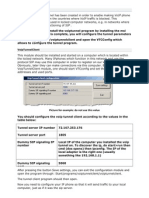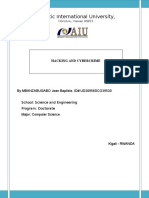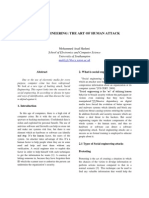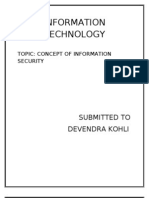What Is A Trojan?: Overt Channel
What Is A Trojan?: Overt Channel
Uploaded by
nitin_manjCopyright:
Available Formats
What Is A Trojan?: Overt Channel
What Is A Trojan?: Overt Channel
Uploaded by
nitin_manjOriginal Title
Copyright
Available Formats
Share this document
Did you find this document useful?
Is this content inappropriate?
Copyright:
Available Formats
What Is A Trojan?: Overt Channel
What Is A Trojan?: Overt Channel
Uploaded by
nitin_manjCopyright:
Available Formats
What is a Trojan?
A Trojan is a program that pretends to be legitimate program, while It is malicious in nature
and is infecting the system in background and provides access of that system to the
Attacker.
Objectives Of Trojans:
There can be different type of objective:
Using the Trojaned machine as part of a Botnet to stage another attack like DDOS
etc.
Trojans can install Softwares so that they can upload or download files and data
directly from your computer.
Trojans can modify or delete your files.
Trojans also supports Keystroke logging and they can monitor people without their
knowledge.
Wasting computer storage space.
Crashing the computer.
Overt Channel & Covert Channel:
Overt Channel:
Overt channel simply means that the Data which is being transmitting on the network is a
legitimate connection which is following the security policy
An overt channel can be used to create a Tunnel(covert channel) to transmit the data
carefully on the network, which does raise any alarm .
Covert Channel:
Covert channel is simply the connection in which data is being transmitting over the network
that violates the security policy.
The simplest form of covert channel is
1.
Trojan
2.
Backdoors etc.
3.
Http tunnelling to access some restricted data.
Working of Trojans:
An attacker can get access to the system in multiple way.
If the Trojan is direct connecting Trojan then attacker can connect to the victim
directly and can get access to the victim machine, but the scenario is not always that easy.
Victim can be behind a Firewall, in that case direct connection Trojans will not any provide
any access to the victim computer even if the victim is infected.
Here comes the Reverse Connecting Trojans into the scene, In Reverse Connection
Scenario, attacker need to connect to the victim instead reverse connecting Trojan
themselves tries to create and maintain the connection between the victim and attacker
which can bypass firewall if the trojan is using that protocol and port which is allowed from
inside network.
Different Types of Trojan
Remote Access Trojans: Remote Access Trojans provides the whole access of the
machine.
Destructive Trojans: Some trojans are created with a purpose that they will destruct
the normal working or booting procedure of the victim machine.
Denial-of-Service (DoS) Attack: Some trojans works a dump zombies and they wait
for the attacker to give commands and usually they are being used for DDOS attacks.
Proxy Trojans: Proxy Trojans are provides the access of the victim machine in the
same way as the Remote access trojan does , but it gives the additional functionality that
attacker can use the victims machine as a proxy server which will hide the attacker from
being logged.
FTP Trojans: FTP trojans are those which open the ftp port 21 on the victim machine
and allows attackers to access it through ftp client
Security Software Disablers: Some trojans are designed to check and disable the anti
virus, internet security tools on the victim machine thus making them vulnerable to attacks
and prevent themselves from being detected.
Target Data Types of Trojans
Trojans are not restricted to target only the following contents but this what they
actually look for:
Login credentials like Username-password combination and information like credit
card details which may be used by the victim.
Trojans looks for Confidential documents, official documents and personal
documents.
Trojans can also retrieve data like bank account numbers, social security numbers,
insurance information etc.
Trojans can also access calendar information like important meetings and other
notes concerning the victims presence or activity.
Trojans can also stage the victim machine to hack further for some illegal cause and
leave the victim for consequences.
Different Modes of Trojan Infection
Trojans can be spread by any means, some of them are listed here:
Through Internet Relay Chats and messengers like gtalk and yahoo.
Through mail attachments
Trojans can also infect the system through a physical access of the system
Browser and email software security bugs can allow attackers to compromise
machine and then infect it with trojans for future access.
Trojans can also replicate while sharing data within a domain network.
Untrusted sites and freeware software site also transmits the trojans in an affective
manner.
Auto Run Trojan
The AUTORUN.INF file must start with the following line:
[autorun]
For example to create a CD or pen drive that will autorun the program server.exe
would require an AUTORUN.INF file similar to:
[autorun] open=server.exe icon=setup.exe to create a CD that will autorun to open
the html file index.htm would require:
[autorun] ShellExecute=index.htm icon=index.htm However, since some older
versions of Windows do not support ShellExecute a less elegant alternative would be:
[autorun] open=command /c start index.htm icon=index.htm Be aware that the use of
command and start restrict this to machines running Windows.
So, By using Auto run feature you can spread your trojan very easily
Symptoms of a Trojan Infection
Common symptoms of a trojan infected machines:
CD-ROM drawer opens and closes by itself
Computer screen flips upside down or inverts
Wallpaper or background settings change by themselves
Documents or messages print from the printer by themselves
Computer browser goes to a strange or unknown web page by itself
Windows color settings change by themselves
Screensaver settings change by themselves
These are common effects that user experience after infected by a trojans like beast and
prorat.
Ports Used by Trojans
Trojan
Ports
==================
Deepthroat
6670
Netbus
6666
Prorat
5110
Secret agent
11223
Asylum
23456
Binder and wrappers:
Wrapper or binder is an application which combines a trojans application with a non
malicious file like an image or any other executable file.
This reduces the suspicion level of the victim over attacker and it also helps in
convincing the victim to execute that wrapped file
Using wrappers, we have combined two different applications as a single file, now
when victim executes that file single wrapped file, it first installs the trojan in the
background and then run the legitimate application after it.
Victim only see the later legitimate application on the foreground.
How to Detect Trojans?
There are several method by which we can scan the presence of a trojan which are as
follows:
By scanning the system for suspicious open ports using tools such as netstat &
TCPview
By scanning for suspicious running processes using process Viewer.
By scanning for suspicious registry entries using the following tools such as
MSConfig.
By scanning what type network connection are being established by using wireshark
and save that data packets capture and analysis them to see to which IP address they are
connecting to.
Avoiding Trojan Infection:
Do not download blindly from any websites that you are visiting.
Do not trust the file even if the file coming from a friend, there may be a possibility
that your friends system is also infected and it might also your system as well, so be sure
what the file is before opening it.
Disable the autopreview or autoplay option from the media that you are connecting to
your computer.
Do not type commands that you have received in a mail from someone or not type
anything in the browser that can a malicious script that may further infect your computer.
Prorat:
You might also like
- Internet Programming ReportDocument20 pagesInternet Programming ReportKhalid Ali MohamedNo ratings yet
- How To Protect Personal Information Against Keyloggers: Virus SignaturesDocument6 pagesHow To Protect Personal Information Against Keyloggers: Virus SignaturesFabienne MaryNo ratings yet
- Cyber AttacksDocument9 pagesCyber AttacksPratik BiswasNo ratings yet
- Chapter6 Malicious Programs and ProtectionDocument25 pagesChapter6 Malicious Programs and ProtectionRashu 900No ratings yet
- Penetration Testing Fundamentals -1: Penetration Testing Study Guide To Breaking Into SystemsFrom EverandPenetration Testing Fundamentals -1: Penetration Testing Study Guide To Breaking Into SystemsNo ratings yet
- Common Windows, Linux and Web Server Systems Hacking TechniquesFrom EverandCommon Windows, Linux and Web Server Systems Hacking TechniquesNo ratings yet
- Impact of Ict On Society: Virus (Trojan Horse, Salami Attack)Document10 pagesImpact of Ict On Society: Virus (Trojan Horse, Salami Attack)Hassani VarcoeNo ratings yet
- Kyrion Ethical Hacking PDFDocument7 pagesKyrion Ethical Hacking PDFAfreen BhumgaraNo ratings yet
- Class 2 Hacking WebserversDocument87 pagesClass 2 Hacking WebserversKazi Mobaidul Islam ShovonNo ratings yet
- Cloud Based SecurityDocument6 pagesCloud Based SecurityEditor IJRITCCNo ratings yet
- Cyber Security: NAME: Priyanka Sudarshan Padhi Class: T. Y. B. Com Div: C ROLL NO.: 294Document27 pagesCyber Security: NAME: Priyanka Sudarshan Padhi Class: T. Y. B. Com Div: C ROLL NO.: 294Pooja PadhiNo ratings yet
- A New Era in Phishing Research PaperDocument15 pagesA New Era in Phishing Research PaperRuchika RaiNo ratings yet
- Ethical HackingDocument19 pagesEthical HackingFarooq MohammedNo ratings yet
- Honeypots For Network SecurityDocument11 pagesHoneypots For Network SecurityPrathyusha KollaNo ratings yet
- Literature Survey On DDOSDocument4 pagesLiterature Survey On DDOSSaikhlum J NarzaryNo ratings yet
- VoIP Tunnel UserguideDocument2 pagesVoIP Tunnel Userguidedan_stern_15No ratings yet
- Setup Guide For Android Devices: Step1: Go To The Wireless and Network SettingsDocument5 pagesSetup Guide For Android Devices: Step1: Go To The Wireless and Network SettingsJana PkNo ratings yet
- Network SecurityDocument17 pagesNetwork SecurityJp CasabonNo ratings yet
- Basics of Ethical HackingDocument6 pagesBasics of Ethical HackingDrm Kapoor100% (1)
- W To Configure Broadband On BSNL Teracom Modem in PPPoE ModeDocument20 pagesW To Configure Broadband On BSNL Teracom Modem in PPPoE ModedkhatriNo ratings yet
- Ransom Ware A Digital ExtortionDocument7 pagesRansom Ware A Digital ExtortionIsaac PalmaNo ratings yet
- Wlan Repeater F SteckdoseDocument2 pagesWlan Repeater F SteckdoseFuad AkNo ratings yet
- Configuring Your Computer For Accumove PDFDocument5 pagesConfiguring Your Computer For Accumove PDFAidenNo ratings yet
- Computer InfestationDocument5 pagesComputer InfestationmwaniaabediNo ratings yet
- Hacking and CybercrimeDocument23 pagesHacking and CybercrimeMbanzabugabo Jean BaptisteNo ratings yet
- Setup or Reconfigure EW-7438RPn Series N300 WiFi Extender - EDiMAXDocument1 pageSetup or Reconfigure EW-7438RPn Series N300 WiFi Extender - EDiMAXRaja Pathamuthu.GNo ratings yet
- Hacking NetBiosDocument6 pagesHacking NetBiosSuresh PaladiNo ratings yet
- NEC Login StepsDocument6 pagesNEC Login StepsAmrNo ratings yet
- Virtual Private NetworkDocument10 pagesVirtual Private NetworkHrishikesh JagdhaneNo ratings yet
- Antivirus Administrator GuideDocument66 pagesAntivirus Administrator GuidejocanetNo ratings yet
- Secure Administrative WorkstationsDocument10 pagesSecure Administrative WorkstationsNavneetMishraNo ratings yet
- IJCRT2104074Document6 pagesIJCRT2104074Anagha MNo ratings yet
- In The CIA TriadDocument9 pagesIn The CIA Triadgadde.lakshmi kiranNo ratings yet
- Cyber Exploits and Vulnerabilities For Ethical HackersDocument10 pagesCyber Exploits and Vulnerabilities For Ethical HackersShaimaa AliNo ratings yet
- Network Layers: The OSI Network Model StandardDocument4 pagesNetwork Layers: The OSI Network Model StandardPrasanna Venkatesan100% (1)
- PenTest 2013 5 PDFDocument68 pagesPenTest 2013 5 PDFproftechitspecialistNo ratings yet
- Shamoon Malware Attacks Aramco: Who, What, When, Where?Document3 pagesShamoon Malware Attacks Aramco: Who, What, When, Where?zahra alsayedNo ratings yet
- Multilayer Framework For Botnet Detection Using Machine Learning AlgorithmsDocument16 pagesMultilayer Framework For Botnet Detection Using Machine Learning AlgorithmsUmamaheswari KMNo ratings yet
- Cyber Espionage Threats - An Alarming Problem: White PaperDocument5 pagesCyber Espionage Threats - An Alarming Problem: White PaperJuan Carlos Baron RinconNo ratings yet
- TYCS SEM - 6 P - 5 ETHICAL HACKING UNIT - 1 Introduction To Information SecurityDocument11 pagesTYCS SEM - 6 P - 5 ETHICAL HACKING UNIT - 1 Introduction To Information SecurityDevika Dakhore100% (1)
- Cybersecuritypedia - Ethical Hacking Questions and AnswersDocument33 pagesCybersecuritypedia - Ethical Hacking Questions and Answersmayurigupta007100% (1)
- Electrochemical DNA SensorDocument8 pagesElectrochemical DNA SensorRaluca RainNo ratings yet
- Comprehensive Review On CNN-based Malware Detection With Hybrid Optimization AlgorithmDocument13 pagesComprehensive Review On CNN-based Malware Detection With Hybrid Optimization Algorithmارشی کماریNo ratings yet
- An Introduction To Undetectable Keyloggers With Experimental TestingDocument6 pagesAn Introduction To Undetectable Keyloggers With Experimental TestingibnuramadhanNo ratings yet
- LAN (Local Area Network) : LAN Stands For Local Area Network. It's A Group of Computers Which All Belong To TheDocument7 pagesLAN (Local Area Network) : LAN Stands For Local Area Network. It's A Group of Computers Which All Belong To TheIas Aspirant AbhiNo ratings yet
- Social EngineeringDocument4 pagesSocial EngineeringAsad HashmiNo ratings yet
- Information Technology: Submitted To Devendra KohliDocument15 pagesInformation Technology: Submitted To Devendra KohliAbhirup UbaleNo ratings yet
- Exploring Novel Ways in Building Botnets: Daniel Mende & Enno Rey (Dmende, Erey) @ernw - deDocument67 pagesExploring Novel Ways in Building Botnets: Daniel Mende & Enno Rey (Dmende, Erey) @ernw - debettyKaloNo ratings yet
- Ethical Hacking HandoutDocument0 pagesEthical Hacking HandoutZaenal AbidinNo ratings yet
- Cracking Social MediaDocument11 pagesCracking Social MediaFaris SyahNo ratings yet
- DDoS in The IoT - Mirai and Other Botnets PDFDocument5 pagesDDoS in The IoT - Mirai and Other Botnets PDFShyam KhadkaNo ratings yet
- Computer Security: Hackers and Viruses: Theory of Computation Mesfer Alrizq Naif AlrashidiDocument83 pagesComputer Security: Hackers and Viruses: Theory of Computation Mesfer Alrizq Naif AlrashidiGhanshyam SharmaNo ratings yet
- Forensic Analysis of Ransomware Infected Windows Hard Disk A Case StudyDocument4 pagesForensic Analysis of Ransomware Infected Windows Hard Disk A Case StudyInternational Journal of Innovative Science and Research TechnologyNo ratings yet
- Cyber Security Q and ADocument14 pagesCyber Security Q and ADeepikaNo ratings yet
- HackingDocument3 pagesHackingvamsikrishnachNo ratings yet
- HackingDocument1 pageHackingAnsh ChaturvediNo ratings yet
- Graphical User Authentication Using Steganography and Random CodesDocument11 pagesGraphical User Authentication Using Steganography and Random Codesruchita chauhanNo ratings yet
- 10 Intrusion Detection FAQDocument8 pages10 Intrusion Detection FAQAnwar Ahmad SobarnaNo ratings yet
- An Overview of Artificial Intelligence Used in MalwareDocument11 pagesAn Overview of Artificial Intelligence Used in Malwarevarerik95No ratings yet
- Tutorial - Fundamentals of Remote Sensing Microwave Remote Sensing - IntroductionDocument3 pagesTutorial - Fundamentals of Remote Sensing Microwave Remote Sensing - Introductionsubbu_843No ratings yet
- Password & SecurityDocument1 pagePassword & Securityjm7369698No ratings yet
- Threat PreventionDocument8 pagesThreat PreventionWM ArielNo ratings yet
- e195687 Applied Cryptography in the CloudDocument15 pagese195687 Applied Cryptography in the Cloudsayuruimesh479No ratings yet
- A Review Paper On Cyber Security: Saloni KhuranaDocument2 pagesA Review Paper On Cyber Security: Saloni KhuranaAtharva PatilNo ratings yet
- Understanding ESAPIDocument51 pagesUnderstanding ESAPISomen DasNo ratings yet
- The Soter Group - 2020 Cyber Security Conference CalendarDocument23 pagesThe Soter Group - 2020 Cyber Security Conference CalendarThe Soter Group, LLCNo ratings yet
- Configuring A VPN Server With Pfsense 3e - Mason BurtonDocument9 pagesConfiguring A VPN Server With Pfsense 3e - Mason Burtonmasonburton56No ratings yet
- Data Breach Recommendation For A Practical Methodology and ImplementationDocument27 pagesData Breach Recommendation For A Practical Methodology and ImplementationbakinaseljeNo ratings yet
- Bosch Camera Data Security TrainingDocument143 pagesBosch Camera Data Security TrainingAlexander Rodríguez BenavidesNo ratings yet
- Asymmetric EncryptionDocument62 pagesAsymmetric EncryptionSyed Sahab Ali ShahNo ratings yet
- Symmetric Encryption, DES, AES, MAC, Hash Algorithms, HMACDocument76 pagesSymmetric Encryption, DES, AES, MAC, Hash Algorithms, HMACMukesh86% (7)
- Combine PDFDocument451 pagesCombine PDFraresNo ratings yet
- Cyber Security and Safety Sneha Das MandalDocument11 pagesCyber Security and Safety Sneha Das MandalSnehaNo ratings yet
- Presentation On Public Key CryptographyDocument29 pagesPresentation On Public Key CryptographyAdnan YusufNo ratings yet
- A Dvanced E Ncryption S TandardDocument48 pagesA Dvanced E Ncryption S TandardJa KovNo ratings yet
- Iam UgDocument860 pagesIam UgThai PhuongNo ratings yet
- Secret Sharing: (Or, More Accurately, "Secret Splitting")Document36 pagesSecret Sharing: (Or, More Accurately, "Secret Splitting")TomBikoNo ratings yet
- Study On Security and Prevention Strategies of Computer NetworkDocument3 pagesStudy On Security and Prevention Strategies of Computer NetworkArfan AfandyNo ratings yet
- Tech Bulletin 97 - MorphoManager With Sigma Multi - Mifare CSN 34 Bit (IA-MFC) or BiometricsDocument5 pagesTech Bulletin 97 - MorphoManager With Sigma Multi - Mifare CSN 34 Bit (IA-MFC) or BiometricsbrandonNo ratings yet
- Sangfor NGAF Report 20211026154435Document11 pagesSangfor NGAF Report 20211026154435Alzi Al-LailNo ratings yet
- Customized AES Using Pad and Chaff Technique Diffie Hellman Key ExchangeDocument6 pagesCustomized AES Using Pad and Chaff Technique Diffie Hellman Key ExchangeIJRASETPublicationsNo ratings yet
- Ella VargasDocument2 pagesElla VargasJhonny BravoNo ratings yet
- Facebook Hacker DownloadDocument13 pagesFacebook Hacker DownloadNewolamNo ratings yet
- Buffer Overflows: ( Dissecting The Exploit)Document32 pagesBuffer Overflows: ( Dissecting The Exploit)Axel LucianoNo ratings yet
- Vulnerability ManagementDocument6 pagesVulnerability ManagementAzeddien SllameNo ratings yet
- Internet and Cyber Security PresentationDocument13 pagesInternet and Cyber Security PresentationNihariNo ratings yet
- Id Vul Id Description LinkDocument3 pagesId Vul Id Description LinkIytzaz BarkatNo ratings yet
- Networks Worksheet 3 Network Security and ThreatsDocument4 pagesNetworks Worksheet 3 Network Security and ThreatshoweqkNo ratings yet
- NSE1Document6 pagesNSE1Cark86No ratings yet
- Lec 02Document62 pagesLec 02Xu YangNo ratings yet

























































































